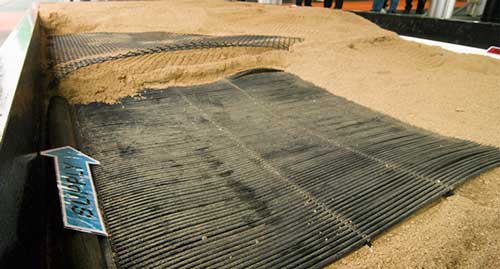
Intel readers were fascinated by the item in our February 24 issue about a cow cooling method that uses very little electricity – cooling freestall beds from below – which had been exhibited earlier that month by GEA Farm Technologies at World Ag Expo in Tulare, Calif.
The system circulates water in a "radiator" mesh of small plastic tubes buried 10 to 12 inches below the surface, as seen in the photo above. The water cools the sand bedding, which in turn cools the cow. A rigid plastic screen is buried about 5 to 6 inches deep to protect the system and to prevent cows from scooping out holes.
Readers from as far away as Slovakia wrote asking two main questions: Isn't there a risk of the water tube mesh being ripped apart during bed grooming; and does the system only work in freestalls and only with sand, and wouldn't using rigid PVC pipes for the water be safer, considering how heavy cows are?
GEA product portfolio manager Terry Thornton said bed grooming must be done with short-teeth rakes, not the long-teeth rakes typically used today. Otherwise, the protective screen will be damaged. Rakes with 3-inch teeth or less are advised.
He says the system has only been tested in freestalls, but in theory should work in other applications. The small size of the plastic water tubes means they are very flexible, and being a foot below the surface means cows' weight is well distributed across the bedding and does no harm to them.
Thornton added that the sand bedding itself is important. It should be free of rocks and sharp pebbles that can potentially puncture the water tubes. But if it happens, it tends to be a single tube, which can be repaired without replacing an entire panel.
Several field tests of the system have been done in conjunction with the University of Arizona, both in controlled environments and in commercial dairy settings.








